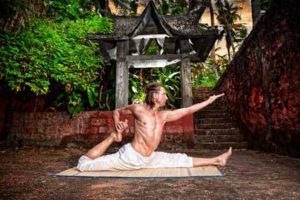 We like to label and categorise things: male, female, young, old, overweight, underweight, fit, out-of-shape … the list goes on. And so it is in yoga: We have classes for ‘beginners’ and ‘advanced’ students. But what does it really mean? And do these labels mean the same thing for all students, studios and teachers? Are we possibly setting ourselves up for proliferating a pretence?
We like to label and categorise things: male, female, young, old, overweight, underweight, fit, out-of-shape … the list goes on. And so it is in yoga: We have classes for ‘beginners’ and ‘advanced’ students. But what does it really mean? And do these labels mean the same thing for all students, studios and teachers? Are we possibly setting ourselves up for proliferating a pretence?
Most people (including yoga teachers) would consider an advanced student as somebody who has mastered the execution of key yoga postures and has become proficient in practicing postures that require more strength, balance or flexibility than what is normally taught in the average yoga class. But this interpretation of ‘advanced’ tells us only about the competency of that student in asana (i.e. on only one of the 8 limbs of yoga). It doesn’t for example tell us anything about his or her dedication to a regular meditation or pranayama practice; it does not take into consideration whether this student is living by the yamas and niyamas (ethical and spiritual guidelines for everyday living); it also fails to consider how learned the student is about the key philosophical texts in yoga. All these things should be taken into consideration if we really want to practice yoga holistically (as the 8-limbed path according to Patanjali). Otherwise, we reduce our practice to merely a callisthenic performance rather than the all-inclusive practice it should constitute. Unfortunately, this is becoming widespread through some lineages promoting ‘yoga competitions’ (which are really just ‘asana’ performances). As such, I find myself being driven away from the label ‘advanced’ and would rather, if we decide to categorise yoga after all, use the term ‘dedicated’ or ‘committed’ as a way to refer to somebody who is a truly devoted yoga student (trying to live by all the 8 limbs, not just by the third limb (asana)).
Of course, that sometimes makes it challenging when running a yoga studio where such definitions are rare: On one occasion a particularly skilled student came to my ‘Core Yoga’ class. And although her asana practice was executed to perfection, she exuded an impatient and dominating energy that pervaded the whole room. At the end, it was clear that she was not satisfied with the class as it moved too slow for her liking and wasn’t ‘advanced’ enough. To me, she was a formidable athlete who had obviously worked hard at her asana practice but I considered all the other yoga students that where in the room that day far more ‘advanced’ yogis than her – simply because they were practicing mindfully and with a loving compassion towards themselves and the other students.
So where does that leave students and teachers? I think in the end, each of us has to come to terms with their own moral and ethical belief of what yoga is to them at a particular phase in their lives, how they want to practice it and how teachers want to communicate this to students.
As for Yogita Yoga, we hope to at least give you a glance during our asana classes of what more there is to yoga. While mastering the perfect headstand or doing a standing back-drop will make you more limber and stronger, it may not necessarily make you a better person. It is our belief that performing asana will assist our bodies to become a strong chariot to help carry us, while exploring a fuller and more purposeful life.
Have a great (8-limbed) practice 🙂
Namaste,
Evelyn

